At first, it looked like a mistake.
The staff of TeenWise, a Minneapolis-based non-profit, crunched the numbers for its annual report on Minnesota teenagers' sexual health. Their calculations seemed to show something unbelievable: the state's teen birth rate had a double-digit decline between 2009 and 2010.
That seemed impossible. Just three years earlier, in 2007, Minnesota's teen birth rate had increased by 1.4 percent; nationally it had increased by 3 percent in 2006. How could the rate then fall so steeply and so quickly?
"We ran the data, and we figured it was a mistake," said Judith Kahn, TeenWise's executive director. "Then, it looked like everybody had a mistake. We talked to others around the country, and they were all seeing a very similar thing."
TeenWise's calculations turned out to be accurate. Minnesota's teen birth rate fell by 10.5 percent in 2010. That same year, the national teen birth rate fell by 9.2 percent. That was one of the fastest annual declines on record until 2013, when the rate declined another 10 percent.
For five years now, America's teen birth rate has plummeted at an unprecedented rate, falling faster and faster. Between 2007 and 2013, the number of babies born to teens annually fell by 38.4 percent, according to research firm Demographic Intelligence. This drop occurred in tandem with steep declines in the abortion rate. That suggests that the drop isn't the product of more teenagers terminating pregnancies. More simply, fewer girls are getting pregnant.
"My jaw dropped," said Laura Lindberg, a senior research associate at the Guttmacher Institute, of seeing the 2013 data, which the federal government published in June. "It feels like we're on this roller coaster with the momentum driving us down, and the slope just keeps getting faster and faster."
"You want to say, well, let's just keep doing what we're doing. But then you have to answer the question: what in the world are we doing?"
The statistic was striking enough that it made it into President Obama's 2015 State of the Union Address. With few remarks at all on the Affordable Care Act — his signature legislative accomplishment — it was one of the only moments that his speech veered towards health care at all.
"We still may not agree on a woman's right to choose, but surely we can agree it's a good thing that teen pregnancies and abortions are nearing all-time lows," Obama said.
The massive decline in teen birth rates is undeniably good news for public health advocates. Teen mothers are significantly more likely to drop out of high school. Most teen mothers do not receive financial support from their child's father; 48 percent live below the poverty line. Avoiding early motherhood undeniably opens additional doors in a teen's future.
But there's something uniquely frustrating about the recent, steep decline in teen birth rates: nobody knows why it's happened. The teen birth rate has gone through a period of decline before: after peaking in 1991 at 62.1 births per 1,000 teens, teen births declined slowly and steadily from the early 1990s and through the mid-2000s, falling by about 2.5 percent annually. There was a narrative back then that made sense: in the wake of a national AIDS epidemic, teenagers took a more cautious approach to sex.
High school students' use of condoms increased from 43 percent in 1991 to 63 percent in 2002. Rates of sexual activity went down, too. The teenagers of the 1990s were having less, and safer, sex — a nearly sure-fire recipe for fewer teens having babies.
But the more recent decline doesn't have a clear explanation.
"We have a pretty convincing story for what was going on between 1991 up until about 2005 or so," said John Santelli, a Columbia University professor who has done extensive research on teen birth. "Now, we're frankly a little stumped trying to explain the recent decline."
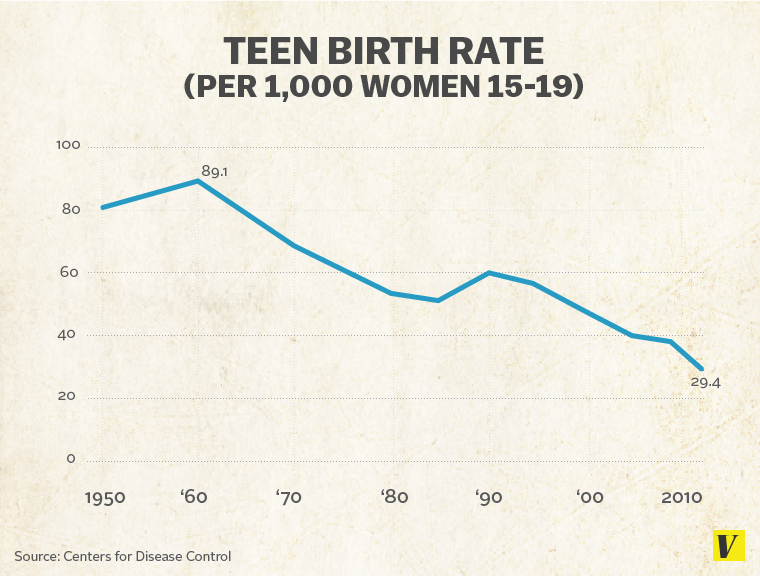
There's nothing analogous to the AIDS epidemic in the 1990s, something they can point to that explains why a behavior changed so significantly.
The recent and rapid decline in the teen birth rate is largely a mystery. It makes it difficult to implement policies to further reduce teen births when nobody knows what's working so well right now.
"You want to say, well, let's just keep doing what we're doing," Lindberg said. "But then you have to answer the question: what in the world are we doing?"
Researchers have lots of theories that range from major changes in the economic climate to minor changes to contraceptive use. But none of them is completely satisfying; all of them leave the decline in the teen birth rate a question without an answer.
The recession theory
As the economy turned south in the late 2000s, demographers noticed the start of a predictable trend: birth rates began to drop. That change makes perfect sense and has shown up in prior economic downturns: couples seem to delay having babies when budgets are tight.
Between 2007 and 2013, the number of babies born each year to mothers of all age groups fell 8.4 percent. Preliminary data from 2013 shows that, last year, there were 3.95 million births — the fewest since 1998, the last time that the country was crawling out of a recession. In 2006, before the recession started, there were 4.31 million births.
Most teenage pregnancies are unplanned; it's unlikely that high schoolers are checking their savings accounts and making a conscious decision to hold off on starting a family until their 401(k)s rebound. But researchers argue that just living in the environment of an economic downturn — having a parent lose a job, for example, or a boyfriend who can't find employment — may encourage more cautious behavior.
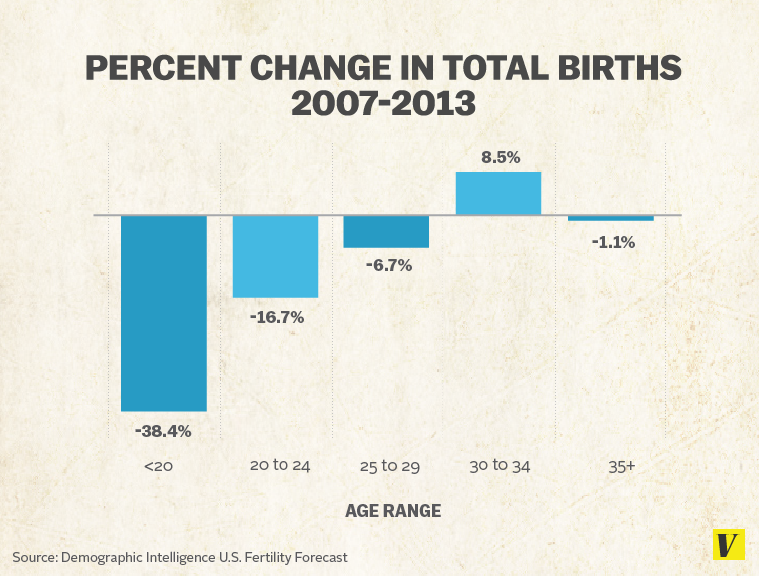
"I tend to see the recession as being very important because it does line up with when the steepest declines started," said Sarah Brown, president and founder of the National Campaign to Prevent Teen and Unintended Pregnancy. "To me, it's the number one cause. People will argue that no teenager is tracking the stock market, but I do think they are acutely aware of what's going on in their household."
But here's what the recession doesn't explain: why the number of teen births fell more than four times faster than the overall birth rate during the 2007 to 2013 period.
Remember that the number of births to teenagers fell 38.4 percent between 2007 and 2013. During that same time period, the declines for other groups were much lower: births to 20 to 24-year-olds, for example, fell by 16.7 percent and births to 25 to 29-year-olds declined by 6.7 percent.
The decline in teen birth rates "is quite unique since the end of the baby boom," said Sam Sturgeon, president of Demographic Intelligence. "We saw some substantial birth declines then, but we haven't really seen anything like this teen birth decline until now."
The IUD theory
In 2005, the American College of Obstetricians and Gynecologists issued Clinical Guideline 539. It's among dozens of guidelines that the group puts out annually, outlining the best practices in reproductive health care.
Clinical Guideline 539 recommended for the first time that long-acting, reversible contraceptives like IUDs should be the "first-line" of contraceptives for all women, including adolescents. Up until then, there was still significant debate over whether the devices, which a doctor implants in a patient's uterus, were safe for younger women. The group subsequently reaffirmed this guideline in 2012.
"It used to be the belief that you couldn't use an IUD in a woman who hadn't had a child," said Guttmacher Institute's Lindberg. "But now it's moved up to be the first choice."
Since the American College of Obstetricians and Gynecologists guideline came out, more teenagers have gravitated toward the the long-acting contraceptive. In 2002, an almost-negligible 0.3 percent of teenagers used IUDs. In 2009, the most recent year for which data is available, 4.5 percent of women between 15 and 19 were using the device.
This could be great news for preventing teen pregnancy, as IUDs are the most effective contraceptive currently available. They require no work on the part of the patient after a doctor inserts the device. Birth control pills and patches — which have to be taken or applied at regular intervals — leave significant space for user error.
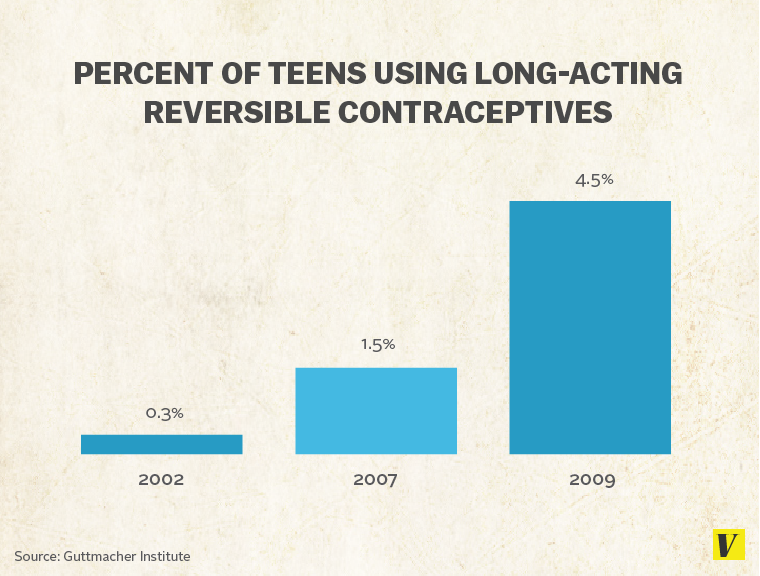
The copper IUD, for example, has a failure rate of 0.8 percent — meaning that for 1,000 women using IUDs, approximately eight would get pregnant. Birth control pills, meanwhile, have a failure rate of 9 percent, more than ten times the rate of most IUDs.
IUD use has shown to be incredibly effective in small experiments to control teen pregnancy. When a Colorado program, for example, made the contraceptives available at no cost to low-income teens, it led to a 40 percent drop in birth rates over four years.
But when looking at the larger, national picture, it's hard to make the case that IUDs — or, more broadly, teens' better use of contraceptives — are responsible for the large teen birth drop. Even with the increases in use, there's still a relatively small group of adolescents using the contraceptive, just under 5 percent.
Many more teenagers rely on birth control pills or condoms, both less effective at preventing pregnancy. And an increasing number of adolescents use no contraceptives at all. In 2013, 13.7 percent of sexually active high school students reported not using any protection, up from 11.9 in 2009, according to the federal government's Youth Risk Behavior Surveillance System. There is not IUD use data available past 2009.
While a small number of teenagers have started using IUDs, a number nearly as large have stopped using contraceptives altogether.
The sex ed theory
In 2008, Milwaukee set a very specific, and somewhat outlandish, goal.
Milwaukee announced that would cut its teen birth rate by 46 percent by 2015. The target was calculated: at the time, Milwaukee had the second-highest teen birth rate of any city, after Baltimore. It would need to reduce the rate by 46 percent, epidemiologists estimated, to get off the top ten list.
"I remember a conversation I had after we announced the target and had other people working on the campaign asking me, are you nuts?" said Bevan Baker, Milwaukee's health commissioner. "It was an outrageous goal, but I think it's what helped keep us on target, that we were working towards something big."
What ultimately proved more outrageous is that Milwaukee beat its 46 percent goal two years early. Recent data revealed that the rate had declined by 50 percent in 2013. In the course of five years, the city cut its teen birth rate by half.
As to how it happened, Baker credits an all-hands-on-deck approach. The city and local businesses poured funds into the effort. They ran innovative ad campaigns, like one that featured teen boys with round, pregnant bellies and the tagline, "It shouldn't be any less disturbing when it's a girl." The local newspaper agreed to a partnership, running articles that underscored the severity of the problem.

(Image courtesy of Serve Marketing)
The United Way of Greater Milwaukee began running pregnancy prevention classes with at-risk teens, using curriculums that had previously been shown to increase knowledge of contraceptives and reduce risky behaviors. Together, this ambitious approach coincided with a massive drop in the number of Milwaukee teens becoming moms — and suggests that it's possible that Milwaukee, and other cities, have gotten much better at addressing a large public health issue.
"I think we hit the timing of it really perfectly," Baker said. "I think you saw decades of public health research being put to work. And you also had this happening with the rise of social media, and all of a sudden we had new ways to spread messages and communicate."
It's hard to doubt that Milwaukee's campaign played a role in the city's especially rapid teen birth decline. These are the type of programs that tend to get credit in local news stories for reducing a particular location's teen birth rate, after intensive effort.
But researchers say it's equally hard to credit those types of efforts with a decline that has happened nationally. For every city that has implemented big, sweeping reforms like Milwaukee, there are dozens of others that have done little — or taken markedly different approaches.
Pregnancy prevention and sex education programs still vary hugely across the country. Fewer than half of the states require schools to teach a sex education curriculum, largely in those in the West and Northeast. Thirty-seven states require that, if sex education is taught, it must include abstinence. Of those, 26 require that abstinence be "stressed" in the teaching.
The data on the teen pregnancy decline doesn't suggest that rates have dropped any faster or slower in states that take a specific approach.
For every city that has implemented big, sweeping reforms like Milwaukee, there are dozens of others that have done little
"What we can say is the teen pregnancy rate has declined across all states, not only in ones that have a certain policy or curriculum," Lindberg said. "There is no one curriculum that's responsible, that you can hold up as the reason this is happening."
Recent federal data suggests that teenagers might be getting less comprehensive sex education now than they used to. A national survey that happens every two years asks high school students whether they received information in school about HIV and AIDS (it does not include a question about pregnancy prevention). Between 2007 and 2013, the percentage of students reporting no such education grew from 10.5 to 14.7 percent.
"There's been a lot of fighting about the sex education curriculum that gets taught, but I don't think we have a solid understanding of what people are being taught right now," Brown, of the National Campaign, said. "I'm not clear what the adult wars about sex ed have accomplished."
The 16 and Pregnant theory
Back in 2010, Philip Levine couldn't name any of the stars of MTV's hit television show, 16 and Pregnant — which makes complete sense for a middle-aged economics professor who teaches at Wellesley College.
That's not true anymore. Levine has now watched dozens of episodes of the show in the service of academic research. And, along with University of Maryland economist Melissa Kearney, he has advanced what is arguably the least conventional explanation of the teen birth rate decline: that the show and its sequel, Teen Mom, account for a full third of the recent drop.
Kearney and Levine's research grew out of a quote they saw in a newspaper article. It was from Sarah Brown, the president of the National Campaign to Prevent Teen and Unintended Pregnancy. Maybe, she suggested, 16 and Pregnant had played a role by realistically depicting the challenges of teen parenting. The show's pregnant stars struggle to finish school, hold jobs, or stay in relationships with their babies' fathers.
"Back in 2010, when the data started coming out, there were all these newspaper articles where every single advocacy group would claim it was their thing, that we finally learned how to address teen pregnancy," Levine said. "Sarah's quote suggested something really different."
Levine and Kearney began looking at changes in the teen birth rate in places where the MTV shows had high Nielsen ratings — and those where it didn't do well at all. And what they saw was areas of the country with high Teen Mom viewership had significantly faster declines in their teen birth rates. They published their first results last year, in a working paper titled "Media Influences on Social Outcomes: The Impact of MTV's 16 and Pregnant on Teen Childbearing."
Kearney and Levine estimated that the two MTV shows are responsible for a 5.7 percentage point drop in the teen birth rate between June 2009 and December 2010 — one third of the total decline during that 18-month time period.
While some expressed worry that the shows glamorized teen parenting, Kearney and Levine argue the exact opposite: the shows are a realistic window into having a baby during high school. Boyfriends leave, weekends are ruined, and college plans get deterred.
Others in the teen pregnancy research community view Kearney and Levine's work with a level of skepticism. Lindberg, at the Guttmacher Institute, notes that their work has not yet been peer-reviewed by other researchers. She suggests that there could be something different about the communities that watch MTV at a higher rate that correlates with, but doesn't cause, the decline.
"It's a work in progress," Lindberg said. "There are lots of cultural influences, and I don't know that any one can explain the decline."
Levine easily admits that 16 and Pregnant is unlikely to be the entire story. One data point his theory has trouble explaining is the steep decline in teen pregnancy rates between 2012 and 2013, long after the MTV shows' ratings had peaked.
"The continuing, rapid decline is the part I find a little confusing," he said. "The recession and the show get you a lot of the way through 2011 and 2012. But I was a bit surprised by the most recent, rapid decline in the 2013 data.
"I can give you more complicated stories that would make it work. I don't think those are implausible, but we don't have an evidence to indicate they're true."
The lead theory
For decades now, researchers have documented a dangerous relationship between a child's early exposure to lead and his or her cognitive development. In a seminal 1979 paper, University of Pittsburgh School of Medicine professor Herbert Needleman linked the amount of lead in young students' teeth to lower IQ scores and worse performance in the classroom.
Needleman didn't stop there: he followed up with the students 11 years later, in 1990, and found that the relationship between lead exposure and slower development persisted into young adulthood. The kids with the highest levels of lead exposure were seven times less likely to graduate from high school.
More recent work has tried to uncover why this would be: what it is about lead exposure that would lead to these outcomes. MRI studies have shown that higher blood lead levels as a young child correlates with brain damage as a young adult, between 19 and 24. The damage is especially pronounced, researchers at the Cincinnati Lead Study have found, in the prefrontal cortex — the area of the brain that regulates decision-making and impulse control.
Rick Nevin, senior economist with ICF International, has looked at this data to argue that exposure to lead paint, and its relationship to cognitive function, can single-handedly explain the steep decline in teen births.
"The time lags are so stunningly consistent that you've got to see this as a key explanation," says Nevin, a consultant who previously worked with the Clinton administration to phase out lead paint in public housing buildings.
Nevin likes to point to a particular chart, which compares the lead blood levels of kindergarten students in the 1990s — and the birth rate of the same cohort when they became teenagers, about a decade later.
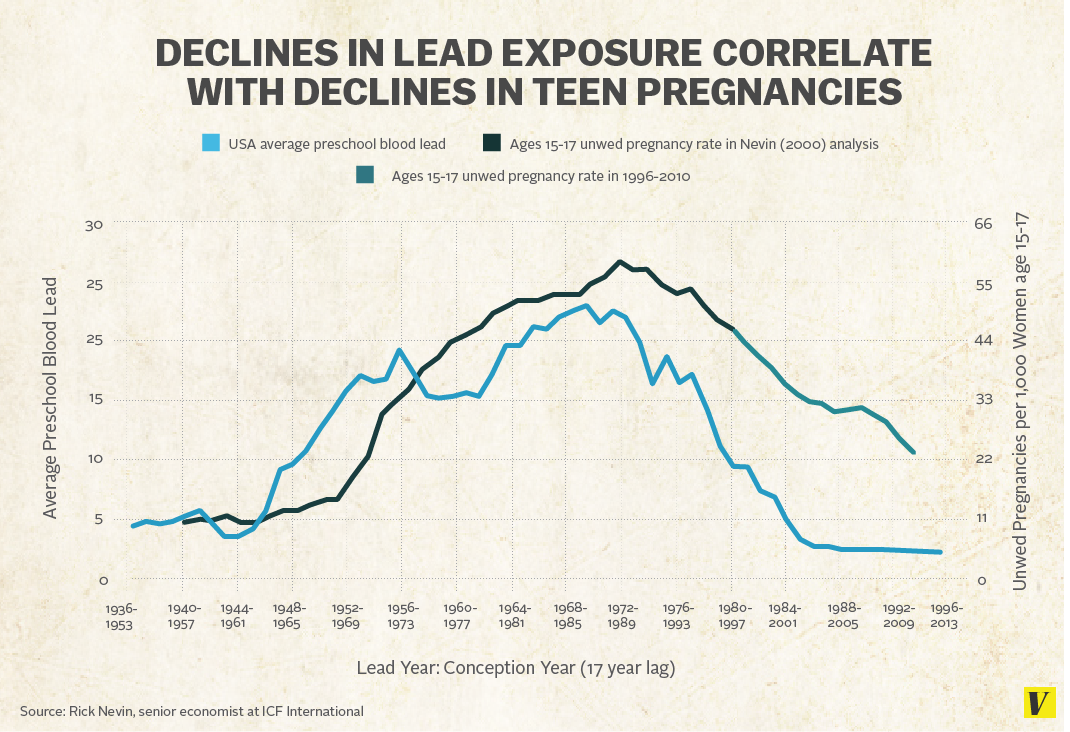
The chart does seem to suggest a leveling off of kindergarteners' blood lead levels in the mid-1990s. But Nevin has separate data showing that flat line, which represents an average, masks a huge decline in the kids who have really high blood lead levels.
While Nevin's research suggests a strong correlation between the changes in blood lead levels and teen birth rates, others are skeptical of whether that is a causal relationship.
"It sounds more theoretical than an actually proven causation," says Heather Boonstra, director of public policy at the Guttmacher Institute.
Separate research from Jessica Wolpaw Reyes, an economist at Amherst College, has been the most head-on attempt to look at the relationship between lead and teen pregnancy. In research published in August, she looked at the effect of states switching to unleaded gasoline in the 1970s and 1980s. She found that a change in blood levels can reduce the likelihood of teen pregnancy by half.
"This suggests that changes in lead could potentially be responsible for some of the decline in teen pregnancy in the 1990s, a decline which has proved difficult to explain," Reyes wrote.
What Reyes' research doesn't look at is the more recent, more steep decline in teen births. "My observations end around the start of the period you're interested in," Reyes wrote me in an email, describing the more recent drop as "definitely a puzzle worth investigating."
The Plan B theory
In 2006, the Bush administration approved the sale of over-the-counter the morning-after pill to women 18 and over. Three years later, a federal judge ordered the Obama administration's Food and Drug Administration to lower the age cut-off for buying over-the-counter Plan B to 17.
Emergency contraceptives can prevent pregnancy if taken within 72 hours of intercourse. And the easier access to these pills, which happened in the middle of the really fast teen pregnancy decline, could plausibly be part of the explanation.
Data on teens' use of emergency contraceptives is frustratingly sparse — and what does exist suggests that teens did not start using Plan B at a particularly high rate after the pill became more accessible.
The Centers for Disease Control and Prevention published a report in 2013 looking at age-related trends in emergency contraceptive use. It shows that teenagers do use Plan B, albeit in lower numbers than older women. The data comes from surveys done between 2006 and 2010, which would all be after the pill moved over the counter for women 18 and over.

One reason researchers are skeptical of this theory: the young teens who had the most barriers to Plan B access are the ones who had the steepest declines in birth rates. The Bush administration only made Plan B available over the counter for those 17 and older; 16- and 15-year-old girls still had to go to the pharmacy with a prescription. Yet it's that younger age group that CDC data shows to have had the fastest decline in births since 2007.
It's possible that older teens or parents are buying Plan B for their younger friends or daughters, giving them easier access to the emergency contraceptive. But if emergency contraceptives were responsible for the decrease in teen births, researchers would expect to see the faster declines in the population that it affected: older teenage women. And they don't.
The internet theory
In 2007, the teen birth rate's rapid decline began — and Apple released its first version of the iPhone. There's a school of thought that argues these two events are not unrelated.
Easier access to the internet on teens' smart phones and laptops could plausibly drive down the birth rate in two ways. Teenagers now have access to information they never had before; they can Google the sex questions that would have been far too embarrassing to ask any parent. That, in turn, could lead to teenagers becoming more educated about pregnancy risks.
The second theory was one that turned up in my inbox repeatedly after publishing the first version of this article: teens spend so much time on the internet that they don't hang out in real life. As a result, there is less sex — and fewer babies.
"No mystery — it's called the iPhone," one reader with a 23-year-old daughter wrote in response to the story. "They now text and do not hang out together."
While data is sparse here too, the little information we have does suggest the internet has become a dominant force in how teenagers learn about sex. In one 2010 survey of 1,500 teens by non-profit Youth+Tech+Health, teenagers said that they learned the most about sexual topics online — more than from doctors, family members, or friends.
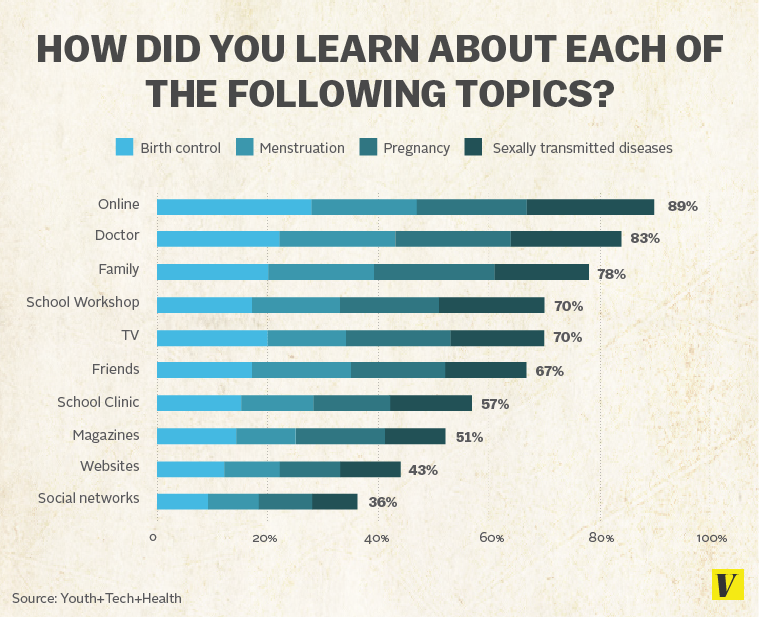
Whether teenagers are finding good information about sex on the internet is a different story. When the same survey asked teenagers what they thought was the most effective way to learn about sex, about 11 percent cited online searches, while 22 percent of men and 19 percent of women cited formal sex education programs in school.
As to the second version of the internet theory — that teens are too glued to their iPhones to have sex — researchers haven't seen any discernible change in levels of sexual activity in the last decade. "There is no evidence of a change from the early 2000s onwards," Guttmacher's Boonstra says.
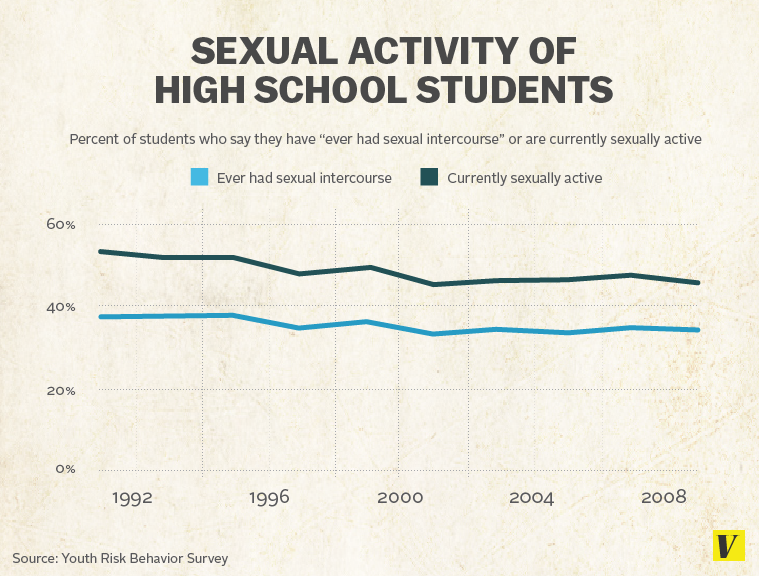
This data comes from the Youth Risk Behavior Survey, a biennial poll of American high school students. It's one of the biggest studies of teens' behavior, but it's also an incomplete data set. It leaves out the teenagers who have dropped out of school and are at an even higher risk of pregnancy.
It's possible that something has changed among teenagers who are not in school that this survey wouldn't pick up. Researchers are waiting for results from the National Survey on Family Growth, which includes teens out of school and is expected to be published this year, to see whether that's the case.
The perfect storm theory
We may have just gotten lucky.
It's not an especially scientific answer, but it's one that seems to describe how teen pregnancy researchers view the dramatic slowdown in the birth rate: a collision of lots of trends that all serendipitously happened in the late 2000s and early 2010s.
The recession, the uptick in IUD use, a hit MTV show that deglamorized teen pregnancy — each of these factors could have have caused a small decline on their own. Taken together, it's possible they caused a much bigger change.
And if that is the case, that doesn't portend especially well for the fast decline continuing. A few of the factors might: use of IUDs, for example, might continue to rise as the health care law eliminates co-pays for the contraceptive. Cost has often been a barrier to IUD use, as co-pays could range between $500 and $1,000.
The other particulars, however, seem less likely to forecast long-term change. The economy is recovering, and so is the birth rate among older women — it's possible that younger women could follow. Teen Mom stopped airing in 2012 (a Teen Mom 2 series still does exist) and 16 and Pregnant, which wrapped up its fifth season this year, doesn't deliver the blockbuster ratings it used to.
Researchers are waiting for the other shoe to drop: there's a general expectation that at some point the statistics have to turn around. "A 10 percent decline per year is not something that happens forever," said Levine. "I don't know that it's necessarily a bad thing if it goes back to the 2.5 percent declines we saw before."
/cdn.vox-cdn.com/uploads/chorus_image/image/36883642/PregnancyTest.0.png)